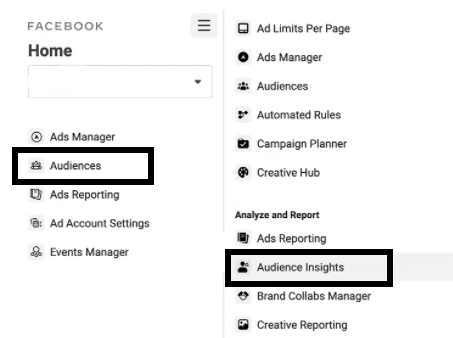Audience Insights inspires campaigns that are meaningful to people and drive actual results for advertisers. It allows you to research your audience, analyze what they like, and segmentation to target the right people. And then you can create targeted ads to generate more leads for your business.
How to Use Facebook Audience Insights
Audience Insights uses third-party data from sources like Acxiom, Datalogix, and Epsilon. So certain data like household and purchase information aren’t available for audiences outside of the US.
1. Access Audience Insights Tool
Navigate to your ads manager, hover over tools, and then select audience insights from the drop-down menu.
2. Select Your Audience
With Audience Insights, you’ll be able to analyze insights for three different groups and choose your audience to get started. Using people on Facebook you can learn about new people to attract them. Select people connected to your page if you want to analyze your existing audience. Or you can select a custom audience to learn about the audience that you’ve already created. For more details check out our Youtube video: How To Create A Custom Facebook Audience 2020
3. Define Your Target Audience
From the left-hand side, you can use filters to narrow down your audience based on location, age, gender, interests, and page connections. Knowing age and gender is not enough for finding the right people to target. Select advanced filters to find audiences based on behaviors, relationship status, education level, job title, household, and purchase. The more filters you apply, the more targeted audiences you will find. And the more focused ads you can create.
4. Discover About Your Audience Using Insights
The middle section of your dashboard displays the results. And from here, you can analyze your audience. Here, you will see six major categories:
- Demographics: includes trends about age and gender, relationship status, and job roles.
- Page Likes: Top categories and most popular Facebook pages your audience likes.
- Location: Information about where your audience is located and the languages they speak.
- Activity: Here you can analyze two major insights.
- Frequency of activities: Analyze activities of your audience’s average comments made, posts liked & shared, and ads clicked in the past 30 days.
- Device users: Note all the devices they use and what are their primary devices.
- Purchase information: (including online purchase behavior), which product categories they’re most likely to shop, and location data. It may help you identify where to run special promotions or host events.
After analyzing, you will get insights into your audience. Where they live, what they do, their interests, activities, and what devices they use. Use these insights to create high-performing Facebook ads.
5. Segment Your Audience
Focus on your ad’s delivery by specifying an audience. You can include or exclude people from your audience based on demographics, location, interests, and behaviors for better targeting Facebook ads.
- Demographic segmentation: Age(0-5, 6-12, 13-17, 18-25, and so on). Gender, Income, Occupation, Education, Family Life cycle, Generation, Ethnicity, Religion, Nationality, Social Class.
- Psychographic segmentation: Personality, Lifestyle, Motives
- Geographical segmentation: Regional, City/County Size, Population Density
- Behavioral segmentation: For example, display ads to everyone who lives within 20 miles of a major city. But exclude people who live in the city itself. There are three types of audiences: Core, Custom, and Lookalike.
If you’re supposing to create ads for iPhone cases. Then segment your audience based on devices, and target this segment to get the most out of your campaign.
Criteria for Successful Customer Segmentation
- Identifiable and Measurable– Characteristics of the segments’ number must be identifiable. Allows the firm to measure identifying characteristics, including the segment’s size and purchasing power.
- Substantial- Must be large and profitable enough to make it worthwhile for the firm. The profit potential must be greater than the costs involved in creating a marketing program specifically for the segment.
- Accessible- The segment must be accessible in terms of communication (advertising, email, telephone). And distribution (channels, merchants, retail outlets, etc.)
- Responsive- Must respond to the firm’s marketing efforts, including changes to the marketing program over time. Respond differently than other segments.
- Viable and Sustainable- Meet the basic criteria for exchange, including being ready, willing, and able to conduct business with the firm. Must also be sustainable over time for serving the needs of the segment.
6. Save and Create Facebook Ads
To save your audience with filters, click on the Save button from the top. Then give a name, and hit confirm button. Or you can directly start creating Facebook ad campaigns. To do so simply click on create ad button from the Facebook ads insights dashboard. Then It will redirect you to the campaign creator and automatically populate your saved audience. Create the right content and publish ads at a right time to drive fruitful results.
Let us know your thoughts in the comment section!

